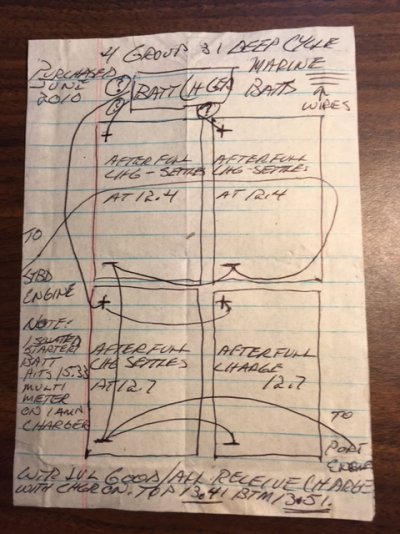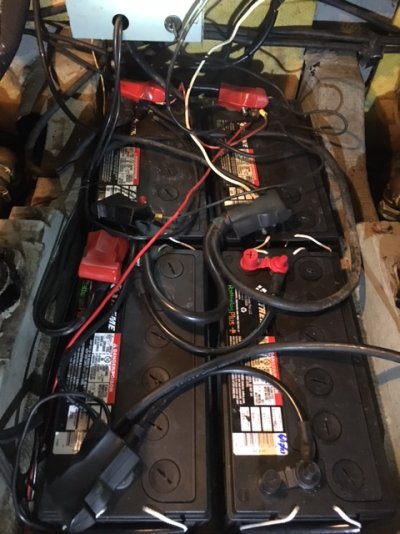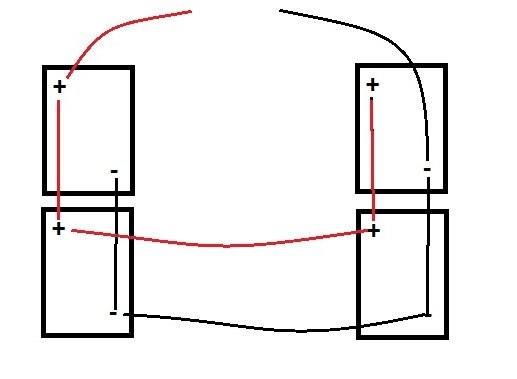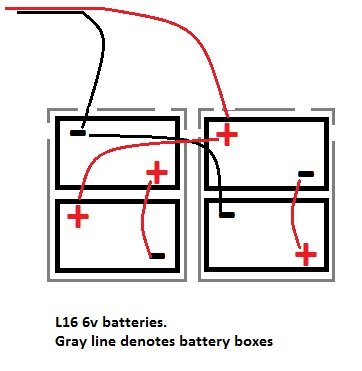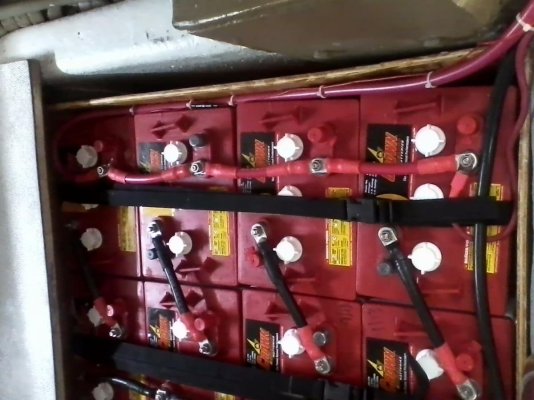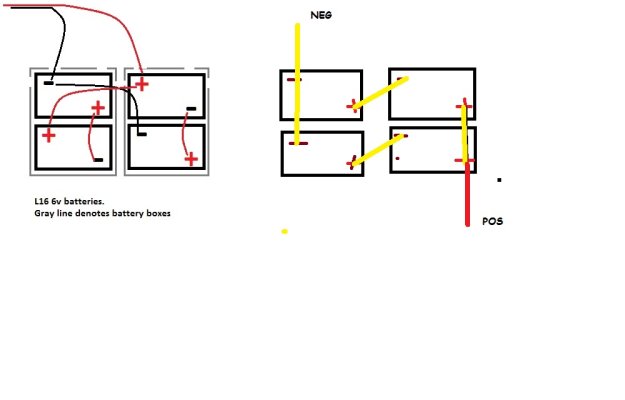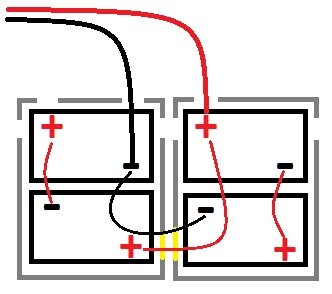Sorry if I missed something, what has that to do with the quality of the shore charger?What if...
You developed a leak of some sort that required constant bilge pump... for several days maybe... while you were away from the boat?
You are using an out of date browser. It may not display this or other websites correctly.
You should upgrade or use an alternative browser.
You should upgrade or use an alternative browser.
Time for new house bank
- Thread starter dhays
- Start date
The friendliest place on the web for anyone who enjoys boating.
If you have answers, please help by responding to the unanswered posts.
If you have answers, please help by responding to the unanswered posts.
What if...
You developed a leak of some sort that required constant bilge pump... for several days maybe... while you were away from the boat?
-Chris
Call my Insurance Company!
BTW: It is my responsibility to make sure that nothing in my boat can or would enable raw water to suddenly, unexpectedly ingress. Therefore, if after all my best intentions and careful planning to have my boat's hull remain water tight were to fail... I'd simply call my insurance company.
Also, our 1977 Tollycraft still has its entire OEM electric system well functioning. That said: This boat's system uses a single stage Professional Mariner battery charger that must have its breaker manually turned on/off. Sooo, even if I left our Tolly plugged into the dock there would not be any battery charging occurring until I or someone else came on board.
If I do ever revamp our boat's battery layout and charging system to modern hi-tech standards - then I might keep the boat plugged in to dock; but not necessarily.
With my boat separated from shore power and its batteries isolated by Perko switches, while it floats "high and dry in its bilge", I have limited to no chance of fire that could ruin my and others' boats. I do have the main bilge pump with float switch direct wired to the house bank.
Additionally, by keeping our boat in fresh water and separating it completely from ac and dc electric sources the chance of corrosive/galvanic electricity-induced metal deteriorating actions [sometimes mistakenly referred to as electrolysis - https://en.wikipedia.org/wiki/Electrolysis] is extremely reduced.
Items I take into consideration [ask you to also contemplate]:
1. How many times do we see a well maintained boat sitting at a dock with its bilge pumps going on and off incessantly because some how that boat suddenly "sprang a leak?
2. How many well maintained boats do we see sunken at a dock from a leak in bilge... and... not due to rain water?
3. How many boats when on the hard are noticed that have considerably expensive metal deterioration due to electrically induced corrosive actions?
As with most things about boat ownership... there is a trade off for everything.
Before all the pomp and circumstance of "new age - hi-tech" super duper electric panel layouts and big-bad battery banks and multi level amperage/voltage charging systems in boats... there were just good ol' alternators [generators at first] on boat engines that kept the battery or batteries charged. Back then, a time in mid 20th Century when I was cutting my "boating teeth", we still kept our boats well afloat!
Happy Boat-Float Daze! - Art

Last edited:
ranger58sb
Guru
Sorry if I missed something, what has that to do with the quality of the shore charger?
Depends on whether Art doesn't leave his charger on while at the dock -- because of the quality of his current charger.
If he always turns it off when he's not there because it's not a 3-stage charger, the situation could conceivably arise where flooding and subsequent bilge pump activity might totally discharge batteries, after which pumps won't work, after which boat could sink.
OTOH, if he got a newer charger and still didn't leave it on when he's not present... not much change.
-Chris
ranger58sb
Guru
Call my Insurance Company!
Et cetera...
Sure, all good points.
As you know, though sometimes Xhit happens.
Anyway, I was only suggesting consideration, just in case... not making a recommendation.
Oh... and twice, I've seen decently maintained boats on our dock "sprang a leak" -- both times in the dripless shaft seals -- that was working on sinking the boat in each case. Had the owners not been there at the time, the boats would have sunk in the slip. OTOH, in those cases, the pumps weren't keeping up anyway...
-Chris
Last edited:
Sure, all good points.
As you know, though sometimes Xhit happens.
Anyway, I was only suggesting consideration, just in case... not making a recommendation.
Oh... and twice, I've seen decently maintained boats on our dock "sprang a leak" -- both times in the dripless shaft seals -- that was working on sinking the boat in each case. Had the owners not been there at the time, the boats would have sunk in the slip. OTOH, in those cases, the pumps weren't keeping up anyway...
-Chris
That is another point regarding keeping all items on a boat in top condition so that a BIG leak does not happen below water line wherefrom bilge pumps become over powered.
Also, because of "dripless shaft seal" potential for severe rupture I only had such for short time on a previous twin screw boat I'd purchased... before removing them and going back to "old school" ways of sealing shaft. I do not use dripless shaft seals on my boats.
You are correct xhit can happen
 ... weather boat remains plugged into shore power with top end multi stage batt charger and robust house bank of batts - or not. The secret is for all boat owners to try our best to not let xhit hit the fan... at all. Any form of bottom leak being a major xhit disturber!
... weather boat remains plugged into shore power with top end multi stage batt charger and robust house bank of batts - or not. The secret is for all boat owners to try our best to not let xhit hit the fan... at all. Any form of bottom leak being a major xhit disturber! I like to keep our boat's bilge completely dry and clean! I bet you are the same way!!

ranger58sb
Guru
I like to keep our boat's bilge completely dry and clean! I bet you are the same way!!
Guilty.
-Chris
I have known this was coming, but the time is now. My almost 7 year old house bank with 3 Chinese made sealed LA 8D batteries is dying. I need to replace it and am trying to come up with options. I am hoping that you all can help me walk through the decision process.
I have a MagnaSine 2812 inverter charger and a 6KW genset. No solar at this time. The other batteries in the boat are an 8D AGM start battery of undetermined age, 2 original 8D sealed LA batteries for the thrusters, windlass, and crane, and a group 27 AGM genset start battery that is a year old.
The batteries are in the aft lazarette underneath the cockpit. They are not easily accessible with very little overhead clearance. In this same space are the thruster batteries, DC electrical panel, and a diesel hydronic furnace. I can changed the form factor of the batteries if needed.
I would prefer to not go with the 8D size again. They are simply hard to manage. However, I certainly can if that is going to be the best option. Watering batteries in this location will be tough. However, I could opt for a watering system if I went with wet LA batteries. I would prefer to spend as little money as possible (I am a sailor after all) but at the same time am looking at long term cost per kWh.
Here are the options as I see them. I am also open to others I haven't thought of.
Wet GC2 batteries - I can buy these at Costco for under $80 each with each pair giving me 210 AH. I could fit 8 to 10 where those three 8D batteries are now by changing the battery boxes. A watering system would keep them watered. It would take a bunch of cables but I figure for under 1 boat unit I could install everything. This would give me 800-1000AH of capacity, 1/2 of which would be usable so 400-500AH.
8D AGM - Other than the 160lbs each, this would be the simplest and easiest to do as three would drop in to replace what I have. More expensive at ~$1,800 for three of them. 700-750AH with about 350-375AH usable.
Firefly Oasis: I would prefer to be looking at this in a couple years instead of now. I'd like to have other folks get more experience with them. $500 each for 116AH. Can be discharged down to 20% SOC apparently, but doing that dramatically reduces the number of life cycles. They claim a 50% depth of discharge will give 3600 cycles, 80% will give 1000. That is still about 2x the number of cycles a wet cell GC2 would have at 50%.
I'm sure there are other options as well. I'm not interested in LiPo batteries at this point and I know there are other form factors which would be good to look at. AGM GC2?
For the way we currently use the boat most of the time, the Oasys is likely overkill. We primarily weekend the boat with an occasional week or two away from dock power. GC2 wet cells would be fine for us but I have an ignorant question. What risk is there to have the wet cells in the same space as the diesel furnace? What is the realistic risk of an explosion due to gas buildup in the same space as a flame?
In my experience with both RVs and boats - the less maintenance the better. I like the AGM. Wet batteries are a pain to maintain and a mess if they leak. There are the new Li batteries. But they are ungodly expensive and are controversial with regard to safety. I don't feel any risk is worth it. Boats and RVs don't do well with fire.
dhays
Guru
- Joined
- May 26, 2015
- Messages
- 9,045
- Location
- United States
- Vessel Name
- Kinship
- Vessel Make
- North Pacific 43
OK, I think I have pinned it down. If I can get a firm quote from Metroplex in TX. I will go a similar direction as Angus. I will go with the L16 AGM 6v batteries.
I also was digging around in my lazarette today and was reminded that the two 8Ds for the thruster bank HAD been changed by the PO. Currently there are 2 Lifeline AGM 8Ds there. The same battery as was used to replace the Engine start battery. So at this point I think I will leave well enough alone on the thruster bank.
Anyway, the only question is 4 x L16 or 6 x L16. 4 would give me 780 Ah weighing 484lbs. This is about the same weight as the current house bank and 30-100Ah more capacity than when the boat was new.
I like the idea of going with 6 however as it would bump my capacity to 1,170 Ah, plenty to drive my wife's CPAP all night and keep me from discharging the batteries very deeply. My only concern is that I would be adding about 250 more pounds in the process. To keep that in perspective it would be about the same as if my son-in-law was sitting in the aft cockpit. Not sure how much I would notice the added weight over time.
I could get 1 battery box that would hold 4 batteries nicely. With a bank of 6, I would likely use three dual boxes.
So, 4 or 6 batteries?
I also was digging around in my lazarette today and was reminded that the two 8Ds for the thruster bank HAD been changed by the PO. Currently there are 2 Lifeline AGM 8Ds there. The same battery as was used to replace the Engine start battery. So at this point I think I will leave well enough alone on the thruster bank.
Anyway, the only question is 4 x L16 or 6 x L16. 4 would give me 780 Ah weighing 484lbs. This is about the same weight as the current house bank and 30-100Ah more capacity than when the boat was new.
I like the idea of going with 6 however as it would bump my capacity to 1,170 Ah, plenty to drive my wife's CPAP all night and keep me from discharging the batteries very deeply. My only concern is that I would be adding about 250 more pounds in the process. To keep that in perspective it would be about the same as if my son-in-law was sitting in the aft cockpit. Not sure how much I would notice the added weight over time.
I could get 1 battery box that would hold 4 batteries nicely. With a bank of 6, I would likely use three dual boxes.
So, 4 or 6 batteries?
- Joined
- Mar 17, 2012
- Messages
- 4,279
- Location
- Australia
- Vessel Name
- Insequent
- Vessel Make
- Ocean Alexander 50 Mk I
OK, I think I have pinned it down. If I can get a firm quote from Metroplex in TX. I will go a similar direction as Angus. I will go with the L16 AGM 6v batteries.
I also was digging around in my lazarette today and was reminded that the two 8Ds for the thruster bank HAD been changed by the PO. Currently there are 2 Lifeline AGM 8Ds there. The same battery as was used to replace the Engine start battery. So at this point I think I will leave well enough alone on the thruster bank.
Anyway, the only question is 4 x L16 or 6 x L16. 4 would give me 780 Ah weighing 484lbs. This is about the same weight as the current house bank and 30-100Ah more capacity than when the boat was new.
I like the idea of going with 6 however as it would bump my capacity to 1,170 Ah, plenty to drive my wife's CPAP all night and keep me from discharging the batteries very deeply. My only concern is that I would be adding about 250 more pounds in the process. To keep that in perspective it would be about the same as if my son-in-law was sitting in the aft cockpit. Not sure how much I would notice the added weight over time.
I could get 1 battery box that would hold 4 batteries nicely. With a bank of 6, I would likely use three dual boxes.
So, 4 or 6 batteries?
Another option! Go for 8 of the L16's. Then when the thruster bank dies, don't replace it. Otherwise you will always be out of sync with battery ages and never be able to merge the two banks. Add a couple of solar panels as well.
I'm happy to spend your money, but in my defence I've been spending my own in the same fashion
Last edited by a moderator:
angus99
Guru
Dave, interesting that my wife discovered she needed a CPAP -- after I'd installed the 8 J305s. (She HATES the device, but that's another story.) I haven't done the math, but I'm happy to have the 1,248 AHs to help with an unexpected all-night 110-V load that certainly draws more from the bank than an anchor light. My logic when settling on AH capacity was to get as large a house bank as the boat could physically and electrically accommodate. While LEDs may drive down consumption, overall it seems like boaters are only finding more and more "needs" for electricity onboard and I didn't want to go through all this and end up wishing I had more--I would never have anticipated a CPAP. And the less I have to rely on the Westerbeke, the better.
Mine are installed on a platform intended for a generator on the opposite side of the bilge from our 780-lb Westerbeke. I'll know when we launch in the next few weeks how much effect it has on boat trim.
I may have missed this, but if you go with the higher capacity will you have to upgrade your cables and fusing? This was not an inconsequential matter on my boat.
Mine are installed on a platform intended for a generator on the opposite side of the bilge from our 780-lb Westerbeke. I'll know when we launch in the next few weeks how much effect it has on boat trim.
I may have missed this, but if you go with the higher capacity will you have to upgrade your cables and fusing? This was not an inconsequential matter on my boat.
sunchaser
Guru
- Joined
- Apr 9, 2008
- Messages
- 10,196
- Location
- usa
- Vessel Name
- sunchaser V
- Vessel Make
- DeFever 48 (sold)
David
Angus had a lot of room (get your tape measure out) in his DeFever's ER to work with as well as time and solid DIY skills. Remember, all you need is a new set of batteries. Several cost effective options that fit in the existing boxes are in front of you. Our reading and commenting pleasure may not match your needs.
JD Cave is an experienced boater and solid thinker. At some point an adequate set of panels along the lines as he suggests would ameliorate any capacity issues a drop in set of new 8Ds may have. Plus, you have a working low hour genset!
Angus had a lot of room (get your tape measure out) in his DeFever's ER to work with as well as time and solid DIY skills. Remember, all you need is a new set of batteries. Several cost effective options that fit in the existing boxes are in front of you. Our reading and commenting pleasure may not match your needs.
JD Cave is an experienced boater and solid thinker. At some point an adequate set of panels along the lines as he suggests would ameliorate any capacity issues a drop in set of new 8Ds may have. Plus, you have a working low hour genset!
Last edited:
Rebel112r
Guru
Dave. Better measure the bottoms of the battery boxes. I went to replace mine 3 seasons ago and American made 8 d would not fit to bottom of boxes. Went with 6 Crown wet batts. Water them once a season and they never use a lot of water. Have used the Odyssey PC1800 batts before on another boat and they were great.
dhays
Guru
- Joined
- May 26, 2015
- Messages
- 9,045
- Location
- United States
- Vessel Name
- Kinship
- Vessel Make
- North Pacific 43
Another option! Go for 8 of the L16's. Then when the thruster bank dies, don't replace it. Otherwise you will always be out of sync with battery ages and never be able to merge the two banks. Add a couple of solar panels as well.
I'm happy to spend your money, but in my defence I've been spending my own in the same fashipon
I was going to do that, but since the thruster bank still looks like it has lots of life in them, I think I will keep them for now. When they do die, I may combine them with the engine start battery. This would free up that huge 8D that is in the ER, and I could replace with 2 x 8Ds, 4 L16, or something new I haven't thought of.
8 of the batteries does add to the cost, plus the weight.
foggysail
Guru
I would recommend against Rolls/Surrette. I bought into the mystique for an off grid house and it was a big, costly mistake. Support was non-existent from factory. I have had two cells fail, and both times it took 3+ months to get replacements. The first was under warranty in the first year of use, and shipping cost as much as the battery would have. The second replacement I bought through a dealer with shipping included in a larger order he had placed. While waiting for the 3 months to get replacements, I had to run the bank at 46v nominal instead of 48v, but fortunately all my gear was sufficiently adjustable to do that.
Never again.
Yes, I was suckered into Surrettes on my sailboat. They even came with pedigree papers which I found didn't make them perform any better than the less expensive batteries that I used up to the time of Surrettes. Enough!

If you agree the big cahuna "sometimes split" with LVD, Main vs Reserve banks idea is sound, best to get as big a "house only" bank as possible now all at once.
Then as the other-banks age, you can repurpose them as starter-only, and then finally recycle off the boat, consolidating the functionality into Main.
Then the next bank purchase will be for a matched new set for Reserve.
This transition plan may take sveral years, and having "too large" a House bank in the meantime will only extend its life by cycling shallower. Yes a bit more weight (insignificant IMO) and a bit more investment up-front, but later much more efficient in both regards.
Then as the other-banks age, you can repurpose them as starter-only, and then finally recycle off the boat, consolidating the functionality into Main.
Then the next bank purchase will be for a matched new set for Reserve.
This transition plan may take sveral years, and having "too large" a House bank in the meantime will only extend its life by cycling shallower. Yes a bit more weight (insignificant IMO) and a bit more investment up-front, but later much more efficient in both regards.
dhays
Guru
- Joined
- May 26, 2015
- Messages
- 9,045
- Location
- United States
- Vessel Name
- Kinship
- Vessel Make
- North Pacific 43
Dave. Better measure the bottoms of the battery boxes. I went to replace mine 3 seasons ago and American made 8 d would not fit to bottom of boxes. Went with 6 Crown wet batts. Water them once a season and they never use a lot of water. Have used the Odyssey PC1800 batts before on another boat and they were great.
I have been measuring them closely. Those Chinese batteries are a bit small compared to a typical 8D. Eventually, I want to add some solar as you did. I think it would make a big difference for me given my typical use.
Angus, my wife hates her CPAP as well, it loves how she feels now that she is sleeping well. FWIW, I ended up buying her another type of mask that she has found to be much more comfortable. She has been using hers now for almost 1 1/2 years and it is worth it.
One of the issues I ran into when looking at what I wanted to do was that because of the way my boat is laid out, if I consolidate the house and thruster bank it would either mean a lot of weight on one side of the boat, or separating the bank in two sections with each being 8' apart and the connecting cables at least 10' long. Even with 4/0 cables I am not sure that I could come up with a reasonable system that wouldn't result in unequal charging and use of the bank in that situation.
So unless one of you electrical gurus can tell me if that is workable, I am back to separate banks for thrusters and house.
Datenight
Guru
Dave. Better measure the bottoms of the battery boxes. I went to replace mine 3 seasons ago and American made 8 d would not fit to bottom of boxes. Went with 6 Crown wet batts. Water them once a season and they never use a lot of water. Have used the Odyssey PC1800 batts before on another boat and they were great.
Dave and Rebel,
I just picked up 8 Trojan 105's to replace the Chinese 4/8? D batteries in the Laz. They fit the NP fiberglass boxes but had to go in side ways not end to end.
Leaving for Greece to help my cousin with his boat Monday so install will have to wait until my return.
Rob
dhays
Guru
- Joined
- May 26, 2015
- Messages
- 9,045
- Location
- United States
- Vessel Name
- Kinship
- Vessel Make
- North Pacific 43
House bank split by distance
I thought I would try asking this again. I would really like to combine my thruster and house banks into one large bank. This would reduce, using CMS's term, the "dead lead" on the boat.
The problem is that I can't put all the batteries on the same side of the boat due to weight distribution issues. Doing so would be like adding moving 800 lbs from one side of the boat to the other.
Does anyone have a sense of how much problem would be created by having essentially a 4 battery bank with two sets of two batteries separated by 10' of cable?
I thought I would try asking this again. I would really like to combine my thruster and house banks into one large bank. This would reduce, using CMS's term, the "dead lead" on the boat.
The problem is that I can't put all the batteries on the same side of the boat due to weight distribution issues. Doing so would be like adding moving 800 lbs from one side of the boat to the other.
Does anyone have a sense of how much problem would be created by having essentially a 4 battery bank with two sets of two batteries separated by 10' of cable?
The connecting wires would ideally all be the same gauge and length, both + and -
If not, I personally think the imbalance issues would be minor.
And completely overcome if you're worried, by rotation say once every six months, as with tires.
And just in case you haven't seen Gibbo's screed http://smartgauge.co.uk/batt_con.html
Or, maybe put them together, see about the weight issue, worst case put in a ballast on the other side?
If not, I personally think the imbalance issues would be minor.
And completely overcome if you're worried, by rotation say once every six months, as with tires.
And just in case you haven't seen Gibbo's screed http://smartgauge.co.uk/batt_con.html
Or, maybe put them together, see about the weight issue, worst case put in a ballast on the other side?
dhays
Guru
- Joined
- May 26, 2015
- Messages
- 9,045
- Location
- United States
- Vessel Name
- Kinship
- Vessel Make
- North Pacific 43
The connecting wires would ideally all be the same gauge and length, both + and -
If not, I personally think the imbalance issues would be minor.
And completely overcome if you're worried, by rotation say once every six months, as with tires.
And just in case you haven't seen Gibbo's screed SmartGauge Electronics - Interconnecting multiple batteries to form one larger bank
Or, maybe put them together, see about the weight issue, worst case put in a ballast on the other side?
Thanks John. That website has a great explanation and that is what I've tried to do in the past. Your idea of rotation is a good one. That might be easily workable, not by moving batteries but simply by moving connections.
The connecting wires would ideally all be the same gauge and length, both + and -
If not, I personally think the imbalance issues would be minor.
And completely overcome if you're worried, by rotation say once every six months, as with tires.
And just in case you haven't seen Gibbo's screed SmartGauge Electronics - Interconnecting multiple batteries to form one larger bank
Or, maybe put them together, see about the weight issue, worst case put in a ballast on the other side?
Don't mean to hijack David's thread, and, hope David can forgive me for placing photos of my batt stuff in here. That said: I feel it's all one way or another for the betterment of boaters' understanding how to deal with marine batt bank hookups.
Link that John61ct provided in post above has some interesting items. Near as I can tell, my batt bank of four [4] G31 LA batts is hooked up in same configuration as #4 in John's link. The preferred hook up method the link reviews. Don't get me wrong... I'm no electrician and love to learn.
Anyway, here are photos of my boat's house bank linking of batt to batt. 1st photo is hand diagram of the link-ups... sans other items showing up in the photo of the batt bank with cover off.
Hope this may help to further expand this thread and look forward to suggestions.
Please Note [on hand drawn diagram]: After time to let all the batts settle down... 12.4 Full Charge number difference regarding the two top batts compared to 12.7 on two bottom batts [I don't understand why that difference??]. Also, mentioned on bottom of page - with charger is on the top two batts show charge level of 13.41 while bottom two batts show 13.51 [top batts is where the charger hooks in]. I might add; when starboard engine is running the same multi meter displays 14.7 across the board.
Attachments
We combined the thruster and windlass with the house bank. The hose bank is 10-t105's with 4 on one side of the engine and 6 on the other. The inverter/charger/major loads are taken from opposite ends of the bank, ie; positive is on battery 1 and negative is on battery 10. The interconnecting cables are 2/0 with 4/0 feeding the inverter/charger and the neutral/positive bus. The thruster and windlass are 4/0 cable also. When we we're anchored out we don't use the thruster and when we use the thruster we aren't out anchoring. 
dhays
Guru
- Joined
- May 26, 2015
- Messages
- 9,045
- Location
- United States
- Vessel Name
- Kinship
- Vessel Make
- North Pacific 43
The connecting wires would ideally all be the same gauge and length, both + and -
If not, I personally think the imbalance issues would be minor.
And completely overcome if you're worried, by rotation say once every six months, as with tires.
And just in case you haven't seen Gibbo's screed SmartGauge Electronics - Interconnecting multiple batteries to form one larger bank
The attached image at the bottom of the post is what I am thinking about doing. I don't think I will get too much difference in the amp draw/charge from the "inside" batteries in the string.
Don't mean to hijack David's thread, and, hope David can forgive me for placing photos of my batt stuff in here.
I don't mind a bit...
Please Note [on hand drawn diagram]: After time to let all the batts settle down... 12.4 Full Charge number difference regarding the two top batts compared to 12.7 on two bottom batts [I don't understand why that difference??]. Also, mentioned on bottom of page - with charger is on the top two batts show charge level of 13.41 while bottom two batts show 13.51 [top batts is where the charger hooks in]. I might add; when starboard engine is running the same multi meter displays 14.7 across the board.
Helpful, thanks.
We combined the thruster and windlass with the house bank. The hose bank is 10-t105's with 4 on one side of the engine and 6 on the other. The inverter/charger/major loads are taken from opposite ends of the bank, ie; positive is on battery 1 and negative is on battery 10. The interconnecting cables are 2/0 with 4/0 feeding the inverter/charger and the neutral/positive bus. The thruster and windlass are 4/0 cable also. When we we're anchored out we don't use the thruster and when we use the thruster we aren't out anchoring.
I was thinking that maybe the long interconnecting cables should be 4/0 since they will have so much further to go than the short interconnecting links. I believe currently all the connections from the house and thruster bank to the DC panel are 4/0.
Attachments
dhays
Guru
- Joined
- May 26, 2015
- Messages
- 9,045
- Location
- United States
- Vessel Name
- Kinship
- Vessel Make
- North Pacific 43
I think I have my solution
Typical for me, after much head scratching and worrying over costs, this is what I've decided to do (at least I have ordered the batteries).
After even more digging around in my very cramped lazarrette I decided to replace the 3 SLA batteries (chinese made somewhere between a 4D and 8D) that when new would have provided 600Ah capacity with 4 x 6v AGM L16 batteries. These will provide a bank of 780Ah capacity at a weight of 484lbs.
I have decided to leave the current thruster bank (2 x 8D Lifeline AGM) as is for now. Currently those are being charged via a Balmar Duo Charge but I am considering combining those two banks at the positive bus bar to create one large bank. Generally it is a "bad idea" to combine batteries of different ages or capacities. However I have yet to be able to figure out what exactly the effect is. However, combined that would give me one large bank of nominally 1280Ah for both house and thruster/windlass duties. That large a bank should be charged at 128amps in bulk and my Magnasine 2812 can do 125amps so that is close.
I want to use the existing 4/0 cables that connect my house batteries to the bus bar but I don't have a lot length to work with. This means that I want to put the pos and neg terminals for that bank within reach of those cables. The 4 batteries will go into two dual boxes with cable cut-outs at one end. This is the configuration I have come up with. Most of you know this stuff better than I, please make sure I'm not missing something here.
Typical for me, after much head scratching and worrying over costs, this is what I've decided to do (at least I have ordered the batteries).
After even more digging around in my very cramped lazarrette I decided to replace the 3 SLA batteries (chinese made somewhere between a 4D and 8D) that when new would have provided 600Ah capacity with 4 x 6v AGM L16 batteries. These will provide a bank of 780Ah capacity at a weight of 484lbs.
I have decided to leave the current thruster bank (2 x 8D Lifeline AGM) as is for now. Currently those are being charged via a Balmar Duo Charge but I am considering combining those two banks at the positive bus bar to create one large bank. Generally it is a "bad idea" to combine batteries of different ages or capacities. However I have yet to be able to figure out what exactly the effect is. However, combined that would give me one large bank of nominally 1280Ah for both house and thruster/windlass duties. That large a bank should be charged at 128amps in bulk and my Magnasine 2812 can do 125amps so that is close.
I want to use the existing 4/0 cables that connect my house batteries to the bus bar but I don't have a lot length to work with. This means that I want to put the pos and neg terminals for that bank within reach of those cables. The 4 batteries will go into two dual boxes with cable cut-outs at one end. This is the configuration I have come up with. Most of you know this stuff better than I, please make sure I'm not missing something here.
Attachments
ranger58sb
Guru
If you rotate the left-side pair 180° and make that +/- interconnect on the far left... and IF your ground cable can still reach the negative terminal of the upper-left-most battery....
You can avoid crossing wires with the +/+ jumpers.
The -/- jumper, if made long enough to be the same length and the +/+ jumper, would have a big curve in it...
-Chris
You can avoid crossing wires with the +/+ jumpers.
The -/- jumper, if made long enough to be the same length and the +/+ jumper, would have a big curve in it...
-Chris
dhays
Guru
- Joined
- May 26, 2015
- Messages
- 9,045
- Location
- United States
- Vessel Name
- Kinship
- Vessel Make
- North Pacific 43
If you rotate the left-side pair 180° and make that +/- interconnect on the far left... and IF your ground cable can still reach the negative terminal of the upper-left-most battery....
You can avoid crossing wires with the +/+ jumpers.
The -/- jumper, if made long enough to be the same length and the +/+ jumper, would have a big curve in it...
Chris, good idea. I think my negative cable would be long enough to reach, but I'm not sure. I still think I would have one crossing cable if I understand your idea correctly. Check the new diagram and see if this is what you had in mind. One of the limiting factors is where the cable cutouts are in the box. However, nothing says I can't take a saw to the boxes and lids and make some new ones.
Edit: As I look at it Chris... If I did but another opening in each box near the bottom on the inside edges, I would be able to lay the parallel links in such a way as to avoid the crossing. Once I get the boxes and lay it all out, I'll see how difficult it will be to make some decent cuts in the boxes. So I changed the new diagram to reflect some new openings in the boxes where the yellow marks are.
The folks here on TF straightened me out on how to wire the batts. Here is what we ended up with. The output cable should be on the far opposite sides of the bank.
You are correct and my proposed configuration actually does that. It is hard to tell however because the way I rotated the batteries. While I am taking the pos and neg leads from the same side of the battery configuration, I am actually taking them the pos and neg terminals on opposite ends of the bank.
Attachments
Last edited:
ranger58sb
Guru
Check the new diagram and see if this is what you had in mind. One of the limiting factors is where the cable cutouts are in the box. However, nothing says I can't take a saw to the boxes and lids and make some new ones.
Edit: As I look at it Chris... If I did but another opening in each box near the bottom on the inside edges, I would be able to lay the parallel links in such a way as to avoid the crossing. Once I get the boxes and lay it all out, I'll see how difficult it will be to make some decent cuts in the boxes. So I changed the new diagram to reflect some new openings in the boxes where the yellow marks are.
Yep, that's how I meant.
Happens to be like ours is evolving -- with some additional complications (windlass ground, and the inverter/charger connections) -- but it only took me three days with PowerPoint to find that layout. And my diagram actually has "Lifeline" on each battery and in the correct orientation.
Essentially, it's two 12V batteries, side by side. Neg (ground) on one, pos on the other. In our installation, our inverter/charger cables physically come from the opposite direction, so those are pos on one, neg on the other. With some curves to avoid crossing.
We're having to make some outside cuts in our box, too, but that's relatively trivial in our case. Even less of a deal than yours, since ours is a single 4-battery box.
Looks like the example Dave shows works equally well, electrically, but our boat connections are not unlike yours and we too have to make the boat connections based on what will reach and the direction from which they travel. At least, when taking the line of least resistance and choosing to NOT have all new boat cables made/laid.
-Chris
Last edited:
Similar threads
- Replies
- 27
- Views
- 3K
- Replies
- 6
- Views
- 761
- Replies
- 1
- Views
- 216

